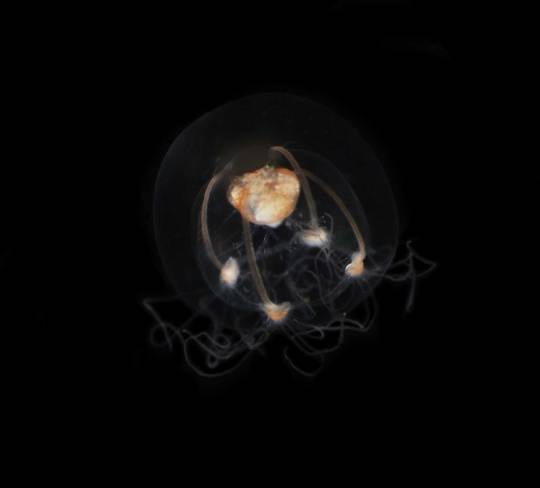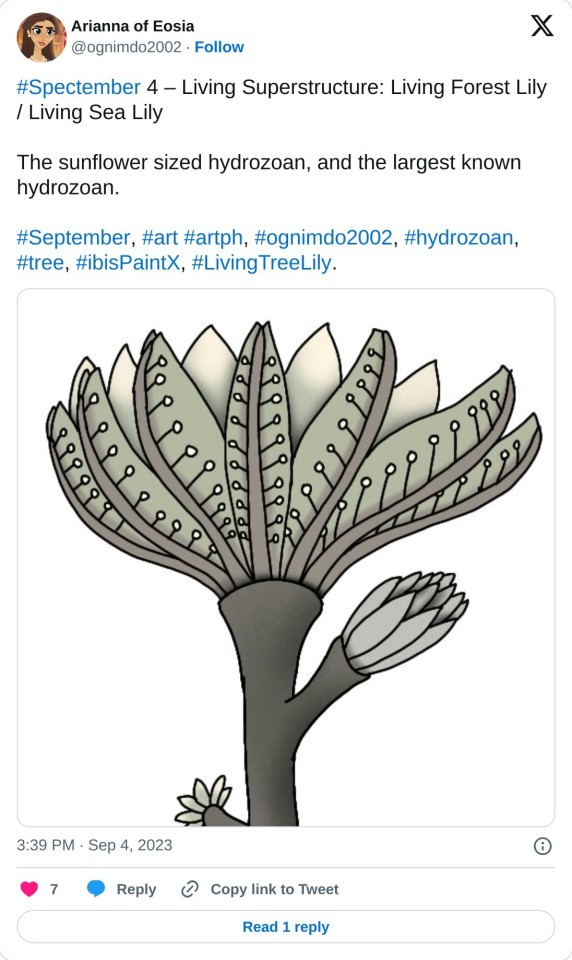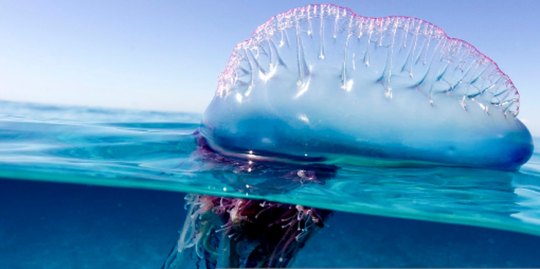#Hydrozoan
Text

Portuguese man o' war with a fish in its tentacles
By: Werner Jacobs
From: Natural History Magazine
1962
#predation#portuguese man o war#siphonophore#hydrozoan#cnidarian#invertebrate#1962#1960s#Werner Jacobs#Natural History Magazine
621 notes
·
View notes
Text
There are approx. 200 species of scyphozoa (true jellyfish)! They’re separated into 4 orders, those being: stauromedusae, coronatae, semaeostomeae, and rhizostomeae.
Hydrozoans are similar, but different. They are closely related and share a lit of similarities.
To help with this: Portuguese man o’wars and by-the-wind-sailors aren’t true jellyfish. Helmet jellies, cannonball jellies, and cauliflower jellies are true jellyfish
#biology#marine animals#marine biology#science#sea life#sealife#jellyfish#sea animals#underwater#fish#sea#sea jellies#seajellies#ocean#cnidarians#hydrozoan#siphonophore#scyphozoa
664 notes
·
View notes
Text

Blue button | Porpita porpita
X
210 notes
·
View notes
Text
Last week on Wet Beast Wednesday I covered some of the biggest animals ever so this week I'm going to do a complete 180 and talk about the smallest animals in this series so far. Not so small as to be micro-animals (I'm sure I'll get to tardigrades eventually) but pretty small. Meet the hydra, a genus of freshwater cnidarians that can be found in temperate and tropical water worldwide. There's a lot of neat stuff about these tiny critters. Such as the fact that they're immortal, but we'll get to that in good time.

(image id: several hydras attached to a rock. Each hydra is a long, anrrow tube that branches at the top into 4 or more thin tentacles. They are milky-white in color. Source: Jan Hamrsky)
Hydras are visually similar to tiny anemones, but they're more closely related to siphonophores and jellyfish. Their bodies are pretty simple, consisting of a tubular body. On one end of the body is the basal disc, a simple foot that adheres to substrate. On the other end of the tube is the mouth, which leads into the gut. Ringing the mouth are tentacles that are covered in stinging cells. The gut is pretty simple and like other cnidarians, it doesn't go all the way through. That's right, when a hydra poops it comes out the same way it went in. A typical hydra consists of 50,000 to 100,000 cells and I hope for their sake that none of them are used for taste. Hydras are diploblastic, consisting of two layers of cells. For comparison, all vertebrates are triploblasts, with three cell layers. The hydra's layers are the epidermis on the outside and the gastrodermis making up the gut. Separating the layers is a gelatinous matrix called the mesoglea that functions as a hydrostatic skeleton. Hydras can contract their bodies and will do so if disturbed. When fully extended, they reach no longer than 10 mm (0.4 in). Hydras are in the cnidarian subphylum medusozoa. Other animals in this subphylum go through two stages of their lifecycle, a polyp that attaches to some substrate and a free-swimming medusa. In most, the polyp is a larval stage that will metamorphose into a medusa during maturation. Hydras instead stay as polyps their entire life. This could be a form of neoteny, the retention of juvenile traits into adulthood. Like other cnidarians, hydras are radially symmetrical. What is most impressive about hydras are their regenerative abilities.

(image id: a drawn diagram of a cross-section of a hydra with labeled anatomical features. source)
Hydras are masters of regeneration. It is this trait that earned them their name, a reference to the hydra of Greek mythology, who would grow two new heads whenever one was severed. Chop a hydra in half and each will grow into a new hydra. Chop a hydra into many pieces and you will get many hydras. Their regeneration is so impressive that if you chop one up into many cells and put them next to each other, the cells will reassemble themselves back into the original hydra. Similarly, hydras primarily reproduce asexually through budding, where one hydra will grow a new hydra out of its body. The daughter hydra will eventually split off from the parent and go on to live independently (unlike certain people I knew in high school). The daughter hydra is a genetic clone of the parent. A hydra living in good conditions can make a new clone every few days. In some species, sexual reproduction is also possible and usually only done when conditions are poor. Depending on the species, individuals can be either hermaphrodites or dioecious (either male or female). Gametes are released into the water to fertilize. Imagine if you wanted to make a baby and to do so you took a handfull of sperm or eggs and threw them all over the place, hoping that someone else also did the same thing in the right time and place. Broadcast spawning is weird.

(image ID: photos of a hydra in the process of regeneration. The hydra is green. It is cut in half, creating a head and foot end. Additional photos taken over time show each end growing into a new hydra. source)

(image id: a pale white hydra growing a bud. the bud emerges from below the head and appears as a small tube. The head of the tube is branched into 5 small nubs that will grow into tentacles. )
Hydras are predators that feed on insect larvae, tiny invertebrates, and small enough fish larvae. They use their basal discs to attach to a hard surface like a rock or branch and extend their tentacles into the water. When something brushes against the tentacle, it triggers the stinging cells. These stinging cells are called nematocysts. Each nematocyst can release what is essentially a tiny harpoon that injects neurotoxin into the target. Nematocysts fire so fast that the harpoon can experience up to 40,000 Gs of pressure. Because nematocysts are tiny, an animal that touches a tentacle will be injected with venom from many of them, getting poisoned even more as they thrash about and get tangled up. The tentacle will then transfer the prey to the mouth. Hydras can swallow pretty large prey, expanding and contracting to fit the prey animal into them. It's kind of like a snake swallowing an egg bigger than its head. While typically sessile, hydras can move around. They can slither around on their basal discs, but when they need to move fast, they summersault. When summersaulting, a hydra will reach down and grab the ground with its tentacles. It then detaches the disc and moves it to a new position. This repeats until the hydra finds itself in a good spot. A speedy hydra can move a food few inches in a day. Hydras can also secrete gas bubbles from their basal discs to float around, upside-down, in the water. A hydra will usually only move from its spot in response to pressure such as predation, competition, or lack of food.
youtube
(video: a video of a hydra capturing and eating a mosquito larva. It starts with the mosquito touching a tentacle, which adheres to and stings it. Once the larva is dead, the hydra pulls it in and gradually engulfs it. Despite the larva being larger than the hydra, the hydra can stretch its body to fully swallow the mosquito)
So about that immortality thing. Yeah, it's not just that hydras can regenerate from just about anything, they also don't age. They're kind of like Tolkien's elves in that while they won't die on their own, they can be killed. No undying lands for hydras though. As far as we know. It has been found that hydra stem cells can infinitely renew the body, preventing the effects of aging. This means that a hydra living in a place with no threats could theoretically just keep going forever. They can still die due to predation, disease, starvation, poor environment, and all the other usual suspects. We actually know the gene sequence responsible for this. I tried to read up on it, but genetics is way over my head and it literally game me a headache trying to read. Along with their longevity, hydras also have an incredible ability to repair damage to their DNA. This is important as damage or mutations in DNA accumulate with age. This is why cancer is primarily a disease of old age. As damage accumulates past the body's ability to repair it, eventually a mutation that causes cancer will come along. The longer you live, the more time this mutation has to occur. The hydra's ability to repair its DNA keeps them from all inevitably getting cancer. Naturally, scientists are hugely interested in hydra regeneration, DNA repair, and immunity to aging. If we could figure out how these things work and apply them to humans it would be huge. Expanded, perhaps even indefinite life spans with reduced effects of aging are obvious, but there are other applications. Better DNA repair could vastly reduce the chances of getting cancer or other genetic conditions while regeneration could potentially allow people to regrow limbs or organs. This is obviously still in the realm of speculation, but it's exciting to think about. In conclusion, all hail our immortal overlords, the hydras.

(image id: a hydra growing on the shell of a dead snail. The hydra is a pale yellow color and contracted, causing its midsection to bulge out. A bud is growing from one side of it. Source: Jan Hamrsky)
#wet beast wednesday#hydra#hydra animal#hydrozoan#cnidarians#biology#zoology#ecology#freshwater ecology#freshwater biology#aquatic biology#biological immortality#immortality#regeneration#not like doctor who#Youtube
98 notes
·
View notes
Text
147 notes
·
View notes
Text
i love wikipedia

reblog if you too are a long stringy stingy thingy (technical term)
109 notes
·
View notes
Photo



#043 - Anemind
#044 - Psidarian
#045 - Hydroggoth
(redesign, finally got the final evo how i wanted)
#fakemon#pokemon#water type#psychic type#hydrozoan#cnidaria#sea anenome#anenome#jellyfish#hydra#portugese man o war#colonial organism#lovecraftian#sea monster
194 notes
·
View notes
Text

Two heads are more argumentative than one.
9 notes
·
View notes
Text

Bougainvillia sp.
I don't know a lot about this little guy, but if you have any fun facts please share them!
Photo credit: my photo. High-res, archival quality prints available here
#jellyfish#hydrozoan#cnidarians#marine life#marine biology#my photography#art print#salish sea#ocean#wall art#art shop#prints
5 notes
·
View notes
Text

Portuguese man o' war
By: Unknown photographer
From: Wildlife Fact-File
1990s
784 notes
·
View notes
Text
Man O’War
#portuguese man of war#hydrozoan#cornwall#kernow#ilovecornwall#ilovekernow#west cornwall#cornish coast#cornish countryside#thecornishlife#beach#beach life#cornish nature#cornish wildlife
17 notes
·
View notes
Video
Polyorchis karafutoensis by Alexander Semenov
#Polyorchis#karafutoensis#hydrozoa#Hydrozoan#hydromedusae#jellyfish#sakhalin#the Sea of Okhotsk#underwater#underwaterphoto#wideangle#wide#flickr
4 notes
·
View notes
Text
#poll#wet beast wednesday#sharks#cnidarians#crabs#fish#hydrozoan#siphonophore#marine life#marine biology
3 notes
·
View notes
Text
Living Sea Lily – Forest Flower

Living Sea Lily (Megalopseudocrino nox) or Living Forest Lily is the fictional species of hydrozoan found in Pacific Ocean, which is no country we found.
Physiology
This cnidarian was resemble of lotus, mislabeled as lily, due to the stem. Their skin color was grayish dull green. Their petal like tentacles are yellowish spots connected with veins, grayish brown petiole like tentacles, and yellowish translucent petal like tentacles which is sticking food debris or planktons. Their fungal like thick skin is purposed the nesting site of each small organisms.
Their size was about the size of sunflower, but in underwater. On land, it curled.
Abilities
Like hydrozoan, the living sea lily is regenerative animal, which regrow the corresponding body parts to grow at 15 minutes.
Behavior
The living sea lily is passive and cannot attack us, and larger organisms.
Habitat
This is most dominated hydrozoan and widespread near brine pools to oceanic trenches, only in seafloor spreading by their regenerate bodies. Their eggs are invisible and spewing after the mating season in January to July.
Reference

#ognimdo2002#earth responsibly#science fantasy#earth#art#earthresponsibly#speculative evolution#ibispaint art#living Sea Lily#hydrozoan#cnidarian#art ph#spectember#historya davvun#worldcraftdamnation#rapunzles tangled adventure#assassin's creed#monster hunter#Superstructure#supernatural
1 note
·
View note
Text
By-the-Wind Sailors Invade Orange County Beaches
Marine Biologists Warn Against Touching Them
Marine Biologists Warn Against Touching Them
In recent weeks, many beachgoers have been surprised to find hundreds of jellyfish-like creatures washed ashore in Orange County, California. These creatures, known as Velella velella, are actually not jellyfish at all, but rather a type of hydrozoan.
Also called By-the-Wind Sailors, Velella velella are fascinating creatures that live on the surface…

View On WordPress
#By-the-Wind Sailors#climate change#environmentalism.#hydrozoan#marine biology#ocean ecosystem#Orange County beaches#Velella velella
0 notes
Photo

Portuguese Man O’ War is a highly venomous ocean predator that most people call a jellyfish but are actually Siphonophores, which are free swimming colonial hydrozoans. (Yeah sure they’re closely related and under the same phylum Cnidaria but like the difference matters to me!!). So its just a bunch of organisms zooids or polyps that literally can’t live without each other. They’re made up of 4 main types of polyps, the floater, the one that’s filled with gas that sits on the surface of the water (Pneumatophores), and the others which are the feeding tentacles (Gastrozooid), the capturing tentacles (that’s also work as defense), and the reproductive polyps (Gonozooid). Man-Of-War just drift around open water being blown around by winds and ocean currents, as the Man-O-War drifts around it is constantly searching for food.
#jellyfish#jellies#siphonophore#hydrozoan#hydrozoa#portuguese man o war#polyp#zooid#cnidaria#cnidarians#man-of-war
1 note
·
View note